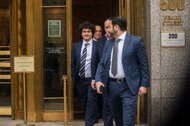Mr. Bankman-Fried, the founder of the collapsed FTX cryptocurrency exchange, was convicted last fall and is serving a 25-year sentence in prison.
Sam Bankman-Fried, the founder of the collapsed cryptocurrency exchange FTX, filed an appeal on Friday, attacking the judge who oversaw his conviction on charges that he orchestrated a sweeping fraud to steal $8 billion from customers.
A federal jury found Mr. Bankman-Fried guilty of fraud, conspiracy and money laundering after a monthlong trial in New York last fall. In March, Judge Lewis A. Kaplan of Federal District Court in Manhattan sentenced Mr. Bankman-Fried to 25 years in prison.
In the 102-page appeal, a lawyer for Mr. Bankman-Fried called for a new trial, pointing to several rulings by Judge Kaplan that limited the FTX founder’s ability to introduce evidence and hampered his defense.
“Sam Bankman-Fried was never presumed innocent,” wrote the lawyer, Alexandra A.E. Shapiro. “He was presumed guilty by the judge who presided over his trial.”
A spokesman for Damian Williams, the U.S. attorney for the Southern District of New York in Manhattan, said the office had no plans to comment on the filing.
An appeal of a federal conviction is always a long shot. Mr. Bankman-Fried, 32, has maintained he is innocent from the moment prosecutors charged him with fraud shortly after FTX collapsed in November 2022. He has been serving his sentence at the Metropolitan Detention Center in Brooklyn, where he has been held since shortly before his trial.
Just two years ago, Mr. Bankman-Fried was a billionaire crypto icon, his face plastered on billboards and magazine covers. But a run on deposits at FTX exposed an $8 billion hole in its accounts, causing the company to implode and prompting a criminal investigation.
Three of Mr. Bankman-Fried’s top advisers at FTX pleaded guilty to fraud and testified against him at trial. The first of those cooperators, Caroline Ellison, who was Mr. Bankman-Fried’s on-and-off girlfriend, is scheduled to be sentenced on Sept. 24.
In the appeal, Ms. Shapiro criticized a ruling by Judge Kaplan that prevented Mr. Bankman-Fried from arguing in court that FTX’s users had not actually lost money, because they are poised to recover funds in the bankruptcy process.
“The government thus presented a false narrative that FTX’s customers, lenders, and investors had permanently lost their money,” the filing said. “The jury was only allowed to see half the picture.”
The filing also argued that Judge Kaplan had improperly prevented Mr. Bankman-Fried from testifying that he relied on legal advice to make some of the business decisions that prosecutors attacked at the trial. Mr. Bankman-Fried spent several days on the witness stand, in a risky bid to win the jury’s sympathy.
Ms. Shapiro took issue with an order Judge Kaplan made during the trial that required Mr. Bankman-Fried to sit for “a pre-testimony deposition” outside the presence of the jury, before he took the stand. The judge said the hearing was necessary to decide how much Mr. Bankman-Fried could tell the jury about his discussions with FTX’s lawyers.
Ms. Shapiro argued that the preview of Mr. Bankman-Fried’s testimony was an “unprecedented proceeding” that “permitted a prosecutor to conduct cross-examination going way beyond the supposed purpose of this preview hearing.”
A new trial should be conducted before a different judge, the filing said.
“The judge repeatedly made biting comments undermining the defense,” Ms. Shapiro wrote. “Even deriding the defendant’s own testimony during the preview hearing and in front of the jury.”
Mr. Bankman-Fried’s lawyer also objected to the role of Sullivan & Cromwell, which served as FTX’s outside legal counsel and later became its main bankruptcy lawyer. She argued the law firm wrongfully pushed him to resign as FTX’s chief executive and became a de facto arm of the government by providing information to federal prosecutors.
